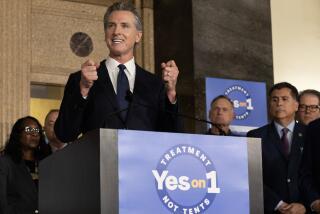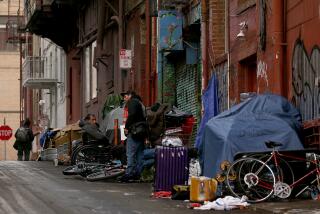Op-Ed: Gavin Newsom’s $1.8 billion early education plan deserves credit, but it isn’t enough

Gavin Newsom got elected doing something that no California gubernatorial candidate had ever done — putting the needs of youngsters atop his agenda.
“Our role begins when babies are still in the womb and it doesn’t end until we’ve done all we can to prepare them for a quality job and successful career,” the new governor said on the campaign trail.
Newsom aims to fulfill his promise with a budget, a draft of which was leaked to the Los Angeles Times, that calls for spending $1.8 billion on an array of cradle-to-kindergarten initiatives. Much of the money would come from an unrestricted tax revenue windfall expected this year.
Newsom’s proposals won’t satisfy the most vocal early childhood advocates, who point to children’s program cuts made during the Great Recession that were never restored. Their proposals, as some of them have told me, start with a $10-billion investment and reach $80 billion in eight years. That’s pie-in-the-sky thinking and the governor lives in the real world.
While Newsom’s additional funding will help, it won’t come close to getting the state where it ought to be: Universal public preschool for 3- and 4-year-olds.
Still, California can and should spend more than Newsom’s budget calls for.
To his credit, Newsom has devised a plan that doesn’t place all its chips on a single initiative or age group. This is wise policy because infants, toddlers and preschoolers all need our attention, and often in different ways. It’s also politically smart because it stops in its tracks the otherwise-predictable fight between champions of child care and champions of preschool.
Concern for equity — reducing the gap between rich and poor by giving kids a smart start — drives the governor’s priorities. The budget underwrites more home visits to expectant parents with limited incomes to bolster their parenting skills. It funds more early developmental screening — as a research brief authored by Stanford University’s Deborah Stipek states, the state does a poor job of identifying kids with disabilities that could otherwise be addressed early on.
The biggest expenditures would go to expanding childcare — training more workers and adding state-supported facilities — as well as to making kindergarten all-day in school districts that can’t afford such programs now. Both efforts would get about a $750-million infusion and both would mainly help low-income families.
All of this is good and necessary, but here’s what’s missing: a major commitment to more and better preschool. In Newsom’s plan, pre-kindergarten for low-income 4-year-olds gets a one-year infusion of just $125 million, with a similar amount anticipated for the next two years.
The state already spends $1.2 billion to subsidize preschool for low-income California families, and it has improved the reach of these programs, but still too few families have access. While Newsom’s additional funding will help, it won’t come close to getting the state where it ought to be: Universal public preschool for 3- and 4-year-olds.
Pre-k for all is a no-brainer. The consensus among researchers is children who attend preschool are less likely to fall behind in later grades, less likely to drop out of high school and less likely to become ensnared in the criminal justice system. A Brookings Institution report shows that fewer than half of poor kids are ready for kindergarten and many never catch up to their classmates. A quarter of middle- and upper-class children are also not kindergarten-ready.
Newsom’s constituents get it — according to the Public Policy Institute of California, three-quarters of the state, including nearly half of Republicans, agree that public pre-k should be available to all. But a 2018 report on the availability of early childhood education from the UC Berkeley Early Childhood Think Tank and the American Institutes of Research shows how far the state’s effort falls short.
Almost a third of California’s 4-year-olds aren’t enrolled in pre-k. And despite the fact that children who go to preschool for two years benefit more, fewer than a third of 3-year-olds have this opportunity.
Enter the Fray: First takes on the news of the minute from L.A. Times Opinion »
For those in the market for a private preschool, the average tab runs about $10,000. (A UC Berkeley education costs almost as much, and at Berkeley, students whose families earn less than $85,000 get an essentially free ride.) According to the 2018 report, nearly half of California families with a 3- or 4-year-old can’t find a preschool slot for their child, regardless of how much they’re willing to pay.
Last month, Assemblyman Kevin McCarty (D-Sacramento) introduced a plan to add $1.4 billion a year — more than 10 times Newsom’s pre-k proposal — to California’s preschool budget. This would allow every low-income 3- and 4-year-old, as well as kids from “middle-income families who are just outside the income limits,” to attend free pre-kindergarten. That’s closer to what Newsom should be proposing, in addition to his childcare and kindergarten initiatives.
Unfortunately, neither McCarty nor Newsom is addressing the quality of preschool as well as access to it. That’s a major omission: Every early childhood education study indicates that the benefits of these programs are tied to highly trained teachers, small classes and an evidence-based curriculum. Studies show wide variation in the quality of California’s programs; unless they improve, putting more children in preschool classrooms won’t help them progress.
Gov. Newsom can assert, with some justification, that he is meeting his campaign promises by adding $1.8 billion to childcare and early education programs in his first budget. McCarty’s bill, which has already gained the support of 15 legislators, suggests Sacramento would be willing to spend much more. The governor — and his supporters — should understand that his proposal as it stands is only a down payment on the high-quality support California’s youngsters need.
David L. Kirp is a senior fellow at the Learning Policy Institute and an emeritus professor at UC Berkeley.
Follow the Opinion section on Twitter @latimesopinion and Facebook.
More to Read
A cure for the common opinion
Get thought-provoking perspectives with our weekly newsletter.
You may occasionally receive promotional content from the Los Angeles Times.





